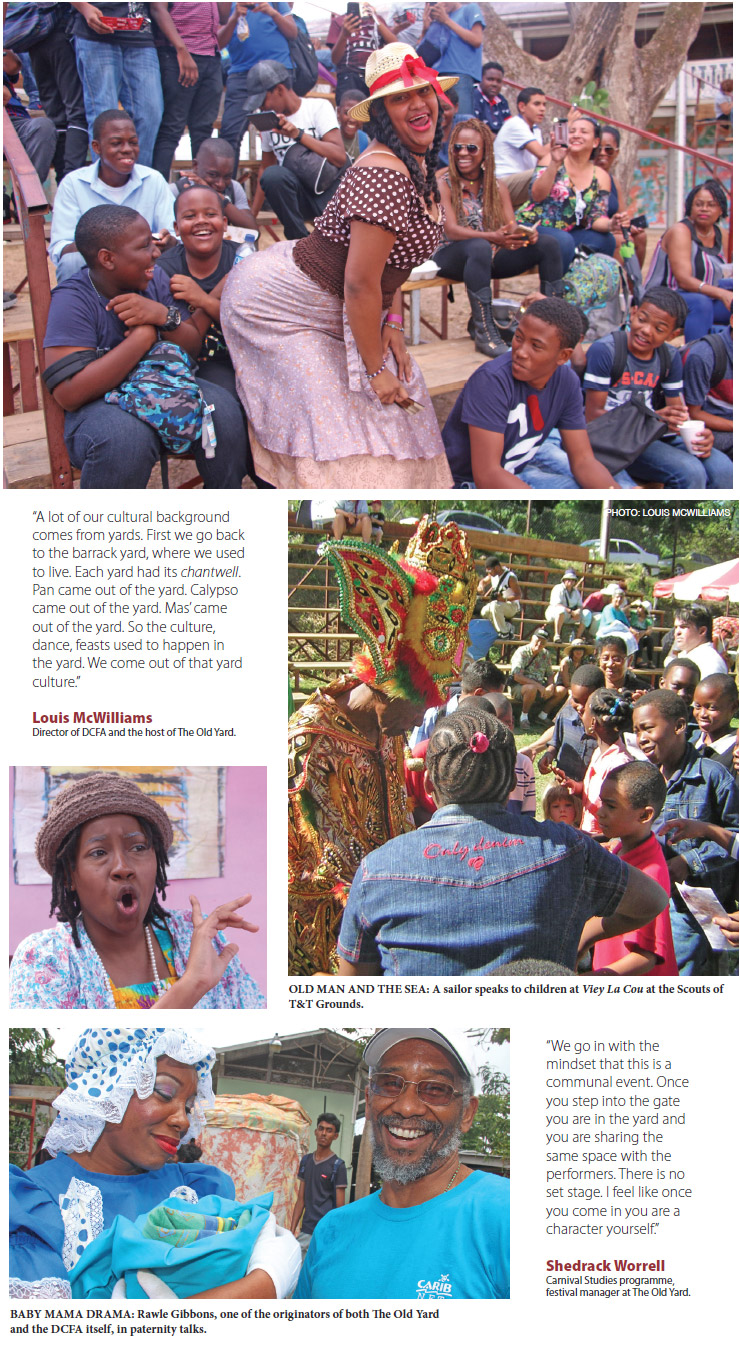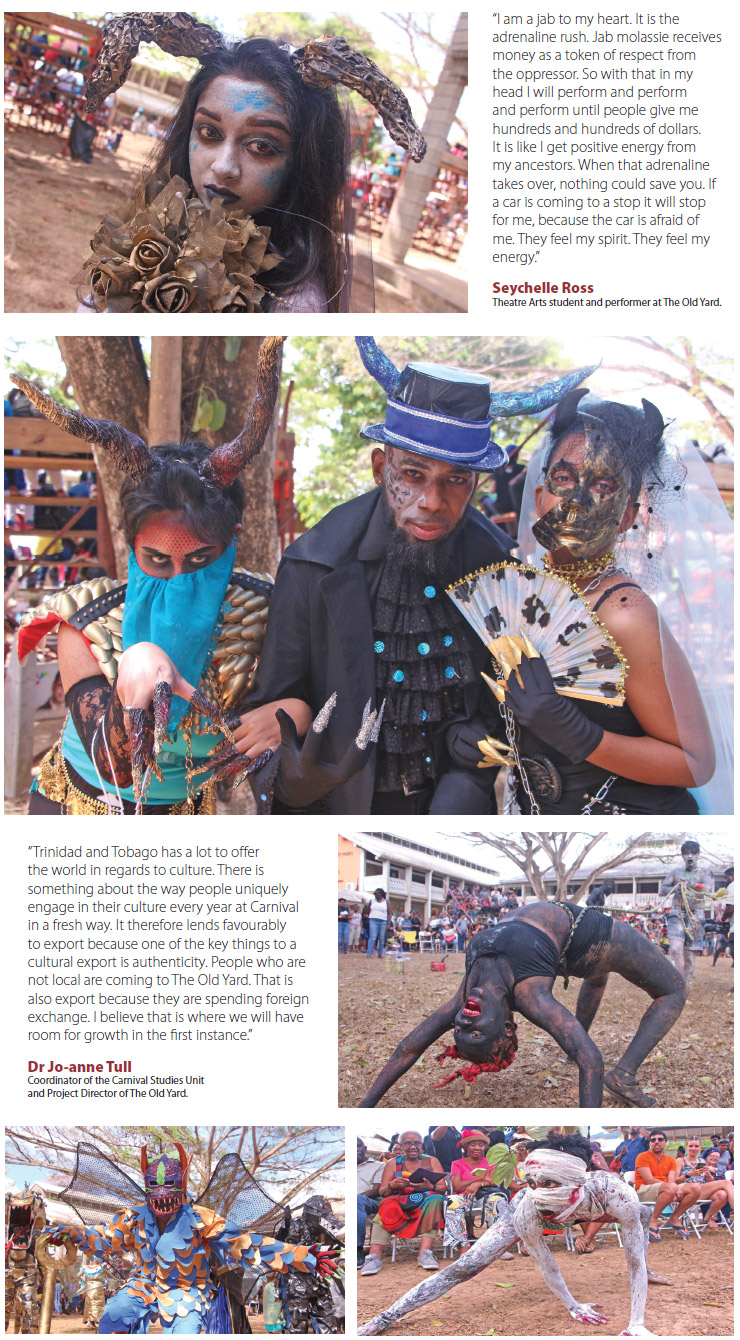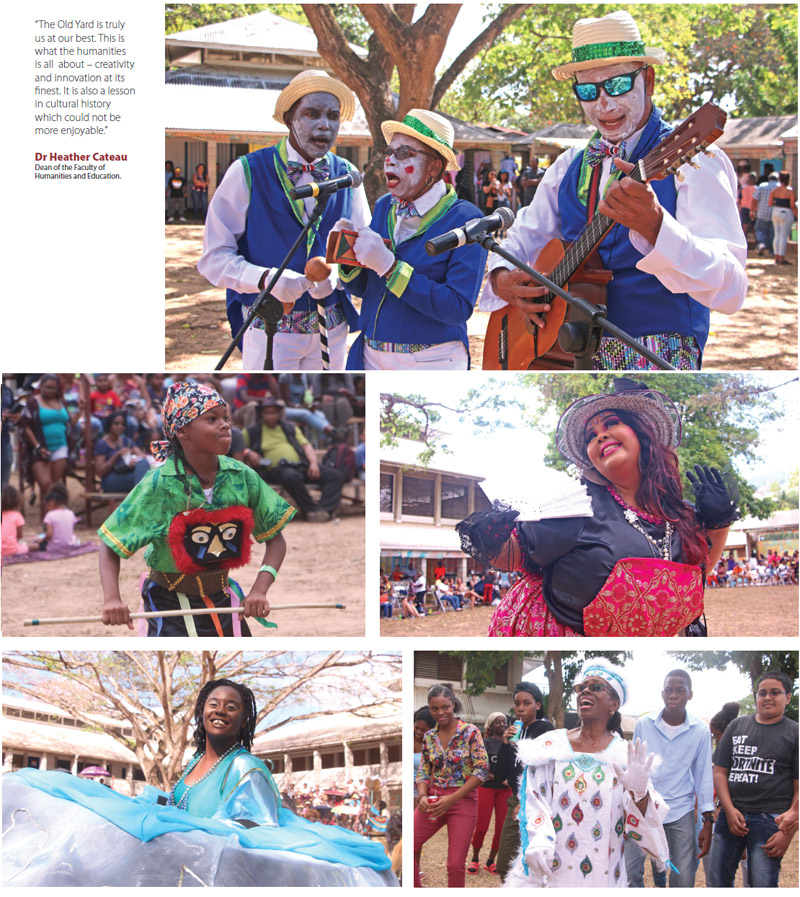
 They called it “A Sense of Home”. On February 24, 2019, the Department of Creative and Festival Arts (DCFA) in the Faculty of Humanities and Education held a special celebration. The Old Yard, DCFA’s annual festival of traditional Carnival, folklore, art and culture, turned 10-years-old. For a decade now, patrons have entered a passageway through time to become part of a cultural experience that stretches all way back to 19th Century Trinidad. They called it “A Sense of Home”. On February 24, 2019, the Department of Creative and Festival Arts (DCFA) in the Faculty of Humanities and Education held a special celebration. The Old Yard, DCFA’s annual festival of traditional Carnival, folklore, art and culture, turned 10-years-old. For a decade now, patrons have entered a passageway through time to become part of a cultural experience that stretches all way back to 19th Century Trinidad.
Once you enter the Yard, “you in it”. It’s a magical experience, enjoyed by the many children, foreign visitors, culture lovers and lovers of Carnival that come out to the sprawling Open Campus Quadrangle at Gordon Street, and came out to the DCFA’s classic Agostini Street headquarters before that.
But while the patrons enjoy the show, the DCFA – and its students do the work. Over its 10 years The Old Yard has become a teaching tool for young festival managers and performers. It has helped to build a community of culture professionals. It has helped to not only rescue but breathe new life into waning traditions. It has made an aspect of our history so vibrant that it has become our future.
That is The Old Yard’s greatest gift to Trinidad and Tobago. It has taken old mas’ and turned it into something fresh and new. What better way is there to keep the culture going strong?
A Sense of Home
By Joel Henry
A Dame Lorraine bounces across the yard in her colourful dress, flapping her fancy fan. The gorillas in their heavy fur suits are in the stands troubling people. The regal sailors, old gentlemen and gentle ladies of mas’ are teaching their dance moves to the young people, adorned, encrusted and shiny. The Old Yard is underway. It’s happened many times before but this time is different. This one is extra special.
“We are celebrating 10 years so naturally we see this edition of The Old Yard as something very special,” says Dr Jo-anne Tull. Tull, Lecturer and Coordinator of DCFA’s Carnival Studies Unit, has been the Project Director of The Old Yard since its beginning in 2009. She and her small team of people from on and off campus, and many students, have over the years created a unique legacy of performance, event management, education, historical preservation and culture, in a most entertaining package.
But to call The Old Yard a “beginning” is not completely accurate. There is an ancestor:
“Before The Old Yard was Viey La Cou,” says Louis McWilliams, Director of the DCFA and Coordinator of the Theatre Arts Unit. “Viey La Cou came at a time when traditional mas’ seemed to be dying. It was the brainchild of people like Rawle Gibbons (dramatist, educator and founder of the DCFA) and Val Rogers (mas’ man and former chairman of Queen’s Hall), who brought this event to Queen’s Hall.”
McWilliams, who describes himself as “the cog in the wheel between Viey La Cou and The Old Yard” has been the host/voice of both events from inception. Viey La Cou went on for many years, growing past the capacity of the Queen’s Hall car park and moving to the Scout’s Association of T&T grounds. The small team, about a handful of people, did incredible work with support from organisations such as the National Carnival Commission and the community of traditional masqueraders but eventually they decided it was time for fresh energy and institutional support. So they brought it to The UWI. And The Old Yard was born.
School Yard
“Old Yard is definitely one of a kind,” says Shedrack Worrell, a 22-year-old student of the DCFA’s Carnival Studies programme currently pursuing a communications degree at The UWI. In 2018, Shedrack worked at The Old Yard. If you were there most likely you never saw him. That means he was doing his job well.
As part of the course “Festival Management”, Shedrack and his fellow students made up the majority of the team managing The Old Yard. They handled stage management, sanitation, accreditation, every function involved in running an event.
“I teach hands-on,” says Tull. “We do a lot of learning by doing. I believe if you have to manage something well you have to know it from the bottom up.”
The same goes for the student performers. Unlike the backstage team they were very visible. Many of the characters on display - jab molassies, bats, dragons, pierrots, jammette, woman looking for a husband, and others - are theatre arts students.
“I was Granny,” says Seychelle Ross, age 21, of her 2017 Old Yard role. “She is just a big, round, fluffy granny that loves everybody. But don’t get her vex or she will cut your tail in front of everyone.”
Seychelle, a third year student from San Fernando, is a young powerhouse. Last year she won the Miss UWIverse competition. She’s also a literal fire breather. She is a lover of jab molassie mas’ and is a member of the collective Jab-a-Mien.
One of the most impressive aspects of The Old Yard is the level of performance from the students. They give their total commitment and draw you into the world that has been created.
“I think that’s my joy now, being in The Old Yard for so long, looking at the participation of the youths,” says McWilliams.
And through these young people a cultural resource has been rebuilt. “There are students who have graduated and go on to continue to perform as traditional characters. Characters that we used to have to go outside and get now we can get them from within. Now people call me asking for a midnight robber for an event and there are graduates we can call. To me that is growth and development. It shows the real value of our programme,” McWilliams says.
What was Old is New
2018 was The Old Yard’s first edition at its new headquarters at Gordon Street. “It was a test run,” says Tull. She sees 2019 as a new beginning.
“We saw a lot of new faces last year. When we were at Agostini Street our audience was predominately students, which I am happy for, but last year I also saw a return of a lot of the faces from the Viey La Cou days and I suspect it has a lot to do with the Gordon Street grounds.”
Tull and the team, which includes McWilliams, artistic director Camille Harden, assistant project manager Tamara De Breo, DJ Wayne Rochard, members of the DCFA support staff and people from the event or hospitality industries, are ready for new expansion.
And The Old Yard also partly represents the growth of the DCFA itself, which has developed under the leadership of its previous directors – Rawle Gibbons, Satanand Sharma, Dr Danielle Lyndersay and Jessel Murray.
She wants to work more closely with The UWI, increasing synergies for student recruitment. The Old Yard has already become recognised as a training ground for festival management professionals and performers, helping them find employment opportunities as well as create their own. That’s a major selling point for young people considering a career in the creative industries.
Tull also wants to strengthen ties with the NCC, the Ministry of Community Development, Culture and the Arts, and the many performers who take part in The Old Yard:
“They have been on board with us for many years, providing resources, giving of their time and talent.”
The DCFA is also interested in corporate partnerships. Despite the high quality of The Old Yard funding is a major challenge. If they want to grow it will become even more a challenge.
But looking back at its first ten years, they are happy with what they have done and are looking forward to the next chapter in this new celebration of old mas’.
As Tull says, “I don’t think as much about legacy as I think of the future.”

 

|





